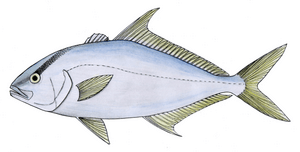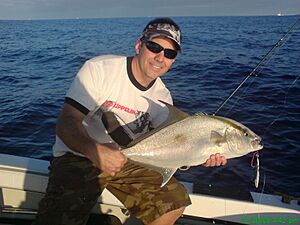Longfin yellowtail facts for kids
Quick facts for kids Longfin yellowtail |
|
|---|---|
 |
|
| Scientific classification | |
| Synonyms | |
|
The longfin yellowtail (Seriola rivoliana), also known as the almaco or silvercoat jack, is a type of game fish. It belongs to the family Carangidae, which means it's related to fish like yellowtail and amberjack.
These fish are meat-eaters. They hunt smaller fish and squid both during the day and at night. The longfin yellowtail's meat is thick and firm, similar to tuna. It's often used in dishes like sushi.
Contents
Discovering the Longfin Yellowtail
Two scientists, Achille Valenciennes and Georges Cuvier, first described this fish species in 1833. Even though Cuvier passed away in 1832, his work with Valenciennes was very important. Together, they described many different fish species. Their most famous work is a huge 22-volume book series called Histoire naturelle des poissons, which means "Natural History of Fish."
What Does the Longfin Yellowtail Look Like?
The longfin yellowtail has a body that is less long and more flattened compared to most other jack species. Its dorsal fin (top fin) and anal fin (bottom fin near the tail) are long. Their outer edges have a distinct sickle shape, like a curved blade.
A special feature of the almaco's dorsal fin is that its longest parts are almost twice as long as its dorsal spines. This is different from other jacks.
These fish usually grow to about 90 centimetres (35 in) (about 3 feet) long. Some can even reach 160 centimetres (63 in) (over 5 feet) and weigh up to 59.9 kilograms (132 lb) (about 132 pounds)! However, most longfin yellowtails caught by fishers are around 10 pounds. The Florida Fish and Wildlife Conservation Commission says they are not a very common catch and usually swim in small groups.
Longfin yellowtails are generally dark in color. They often have faint amber or olive stripes along their sides. Their upper bodies and lower fins are usually dark brown or dark blue-green. The belly is much lighter, sometimes looking brassy or lavender. Adult fish have a dark bar on their neck area (called the nuchal bar) and most of their fins are dark. The only exception is their pelvic fins (fins on the belly side), which are white on their underside.
Where Do Longfin Yellowtails Live?
The longfin yellowtail is a pelagic species. This means it lives in the open ocean, far from the coast, in deep waters beyond the continental shelf. You can find them in small groups on slopes and near reefs. They live at depths from 5 to 160 metres (2.7 to 87.5 fathoms) (about 16 to 525 feet). They also like to visit wrecks more often than other jack species.
These fish are found in many parts of the world:
- In the Indian Ocean and western Pacific Ocean, they live from Kenya to South Africa. They've also been seen near the Mariana Islands, Wake Island, Ryukyu Islands, Kermadec Islands, and New Caledonia.
- In the eastern Pacific, they live from California to Peru and the Galápagos Islands.
- In the western Atlantic, they are mostly found from Cape Cod to northern Argentina. They are not very common off North and South Carolina.
- They are less common in the Eastern Atlantic. They have been found near Great Britain and off Lampedusa in the Mediterranean Sea.
They typically swim at depths ranging from 5–35 metres (16–115 ft) (about 16 to 115 feet).
Amazing Behavior of the Longfin Yellowtail
The longfin yellowtail is known for its incredible stamina. This makes it a popular target for sport fishing in deep waters.
These fish sometimes get tiny parasites on their skin. To get rid of them, they rub against the rough skin of passing sharks! Interestingly, they have also been known to rub against scuba divers, probably because they mistake them for sharks.
Longfin yellowtails can lay eggs (spawn) very often, sometimes as frequently as once a week throughout the year.
Farming Longfin Yellowtails
Longfin yellowtails are being farmed in deep water. For example, they are raised near the Island of Hawaii under the brand name Hawaiian Kampachi. They are also farmed in La Paz, Mexico, as Baja Kampachi. Farming these fish provides a controlled way to get fish meat, similar to wild tuna. In 2008, over 1 million pounds of these farmed fish were produced globally.
Wild almaco jack are plentiful and have not been widely caught for commercial fishing. However, there have been plans for pilot studies to farm them in the Gulf of Mexico.
Sometimes, eating certain fish can cause a sickness in humans called ciguatera. This happens when fish eat tiny organisms called dinoflagellates that produce a toxin. However, farmed almaco jack are fed a controlled diet that doesn't include these dinoflagellates. This means farmed longfin yellowtails are safe to eat and do not cause ciguatera.
These fish are very efficient at turning their food into body weight. For every 1.6 to 2 pounds of special feed they eat, they gain about one pound of fish meat. This is a very good feed-conversion ratio. The meat from these farmed fish can have a fat content of around 30%.
One Hawaiian fish farm raises longfin yellowtail, branded Kona Kampachi, in special net pens. These pens are shaped like rings or diamonds and are anchored to the sea bottom about 800 feet (240 m) (244 meters) deep.
Longfin Yellowtail as Food
The meat of the longfin yellowtail is considered very tasty. It can be prepared in many ways, from completely raw dishes like sushi, sashimi, or crudo, to fully cooked meals like grilled, steamed, or baked fish.
See also
 In Spanish: Seriola rivoliana para niños
In Spanish: Seriola rivoliana para niños


